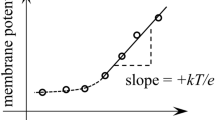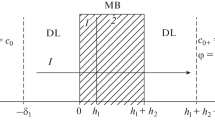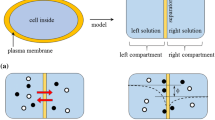Abstract
Mathematical models of the transfer of large enough charged molecules (macroions) have been constructed on the basis of the classical equations of electromigration diffusion (Helmholtz-Smoluchowski, Goldman, and Goldman-Hodgkin-Katz). It is shown that ion transfer in placental barriers (mimicking lipid-protein membrane barriers) and in muscle barriers proceeds by different mechanisms. In placental barriers, the electromigration diffusion takes place through lipid-protein channels formed by conformational alteration of phospholipid and protein molecules, with diffusion coefficients D = (2.6–3.6) × 10−8 cm2/s. The transfer in muscle barriers is due to migration via charged interfibrillar channels with negative diffusion activation energy (explained by changes in the structure of muscle fibers and expenditures of thermal energy for the displacement of Cl− from channel walls), and D = (6.0–10.0) × 10−6 cm2/s.
Similar content being viewed by others
Abbreviations
- DEL:
-
double electric layer
- EMD:
-
electromigration diffusion
- HS:
-
Helmholtz-Smoluchowski
- GHK:
-
Goldman-Hodgkin-Katz
References
Yu. M. Raigorodskii, Yu. V. Seryanov, and A. V. Lepilin, Phoretic Properties of Physical Fields and Devices for Optimal Physiotherapy in Usology, Stomatology, and Ophthalmology (Saratov Univ., 2000) [in Russian].
A. I. Varakin and V. N. Lyasnikov, Izv. VUZov, Ser. Khimiya Khim. Tekhnol. 46(8), 130 (2003).
A. I. Varakin, Izv. VUZov, Ser. Khimiya Khim. Tekhnol. 47(1), 72 (2004).
A. I. Varakin and Yu. V. Seryanov, Izv. VUZov, Ser. Khimiya Khim. Tekhnol. 47(1), 150 (2004).
A. I. Varakin, V. V. Mazur, and Yu. V. Seryanov, Izv. VUZov, Ser. Khimiya Khim. Tekhnol. 47(1), 77 (2004).
V. V. Mazur, A. I. Varakin, and Yu. V. Seryanov, Zh. Fiz. Khimii 80(2), 1 (2006).
V. V. Mazur, A. I. Varakin, and Yu. V. Seryanov, Med. Tekhnika 39(1), 8 (2006).
B. Katz, Nerve, Muscle, Synapse (Mir, Moscow, 1968).
V. S. Ulashchik, Theory and Practice of Drug Electrophoresis (Belarus, Minsk, 1976) [in Russian].
Yu. A. Ermakov, Ross. Khim. Zh. 49(5), 114 (2005).
V. S. Markin and Yu. A. Chizmadzhev, Induced Ion Transport (Nauka, Moscow, 1974) [in Russian].
B. Sakman and E. Neer, Registration of Single Channels (Mir, Moscow, 1987).
L. W. Johnson and C. H. Smith, Biochim. Biophys. Acta 815, 44 (1985).
N. C. Smith and M. G. Brush, Medical Biol. 56, 272 (1978).
J. S. Fidley and W. H. Evans, Biological Membranes (Mir, Moscow, 1990).
Chemical Encyclopedia (Moscow, 1992) [in Russian].
V. G. Ivkov and G. N. Berestovskii, Dynamic Structure of Lipid Bilayer (Nauka, Moscow, 1981) [in Russian].
N. I. Nikolaev, Diffusion in Membranes (Khimiya, Moscow, 1980) [in Russian].
E. Sim, Membrane Biochemistry (Mir, Moscow, 1985).
N. Birks and G. Mayer, Introduction to High-Temperature Metal Oxidation (Khimiya, Moscow, 1978).
C. Fetter, Electrochemical Kinetics (Khimiya, Moscow, 1967).
C. D. Nenicescu, Organic Chemistry (In. Lit., Moscow, 1962).
N. B. Gusev, Soros. Obraz. Zh. 6(8), 24 (2000).
L. E. Bakeeva and Yu. S. Chentsov, Advances of Science. General Problems of Biology (Nauka, Moscow, 1989) [in Russian].
M. M. Shemyakin, Chemistry of Antibiotics (Nauka, Moscow, 1961), Vol. 1 [in Russian].
G. F. Elliott, J. Mechanochem. Cell Motil., 2, 83 (1973).
I. Koryta, I. Dvorzhak, and V. Bogachkova, Electrochemistry (Mir, Moscow, 1977) [in Russian].
L. Edelman, Physiol. Chem. Phys. and Med. 15, 337 (1983).
L. Edelman, Physiol. Chem. Phys. and Med. 16, 499 (1984).
G. N. Ling, A Revolution in the Physiology of the Living Cell (Krieger Publishing Company Malabar, Florida, 1992).
G. N. Ling, A Physical Theory of the Living State: The Association-Induction Hypothesis (Blaisdell, Waltham, Mass., 1962).
Author information
Authors and Affiliations
Additional information
Original Russian Text © A.I. Varakin, V.V. Mazur, N.V. Arkhipova, Yu.V. Seryanov, 2009, published in Biofizika, 2009, Vol. 54, No. 3, pp. 471–481.
Rights and permissions
About this article
Cite this article
Varakin, A.I., Mazur, V.V., Arkhipova, N.V. et al. Diffusion and diffusion-osmosis models of the transfer of charged molecules across biological barriers. BIOPHYSICS 54, 327–335 (2009). https://doi.org/10.1134/S0006350909030129
Received:
Accepted:
Published:
Issue Date:
DOI: https://doi.org/10.1134/S0006350909030129




